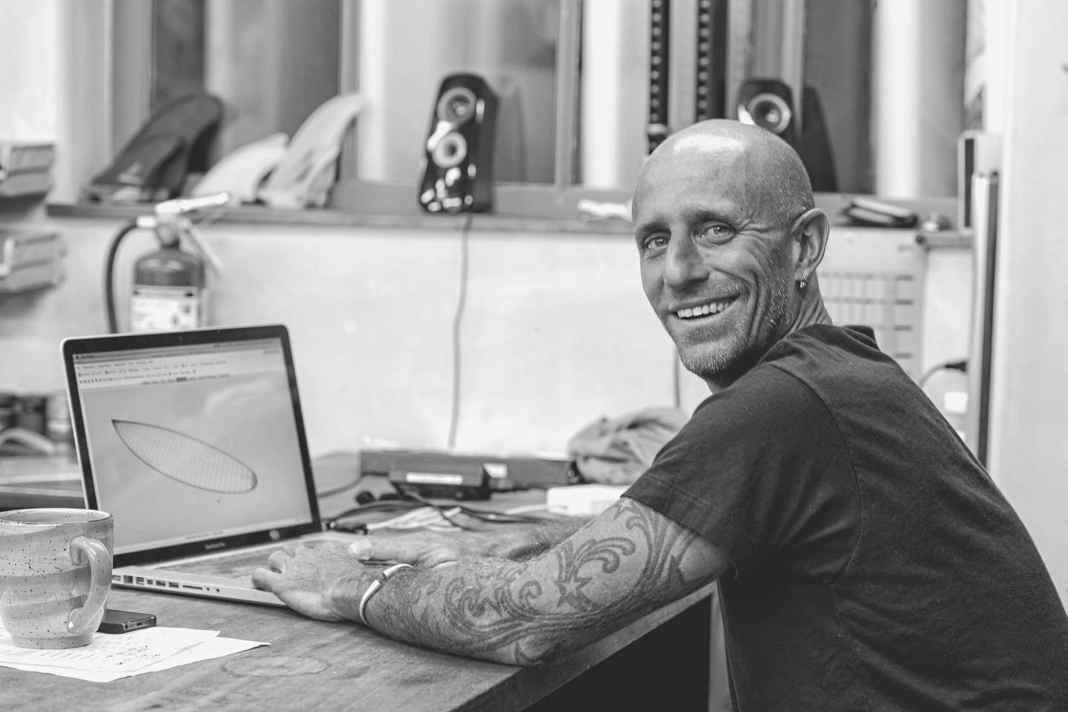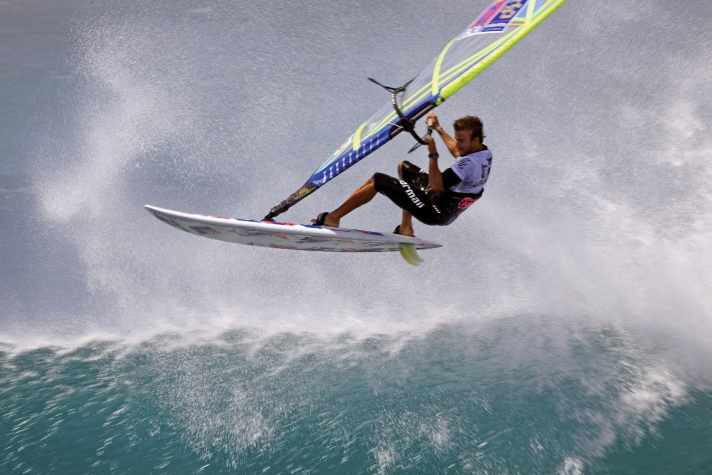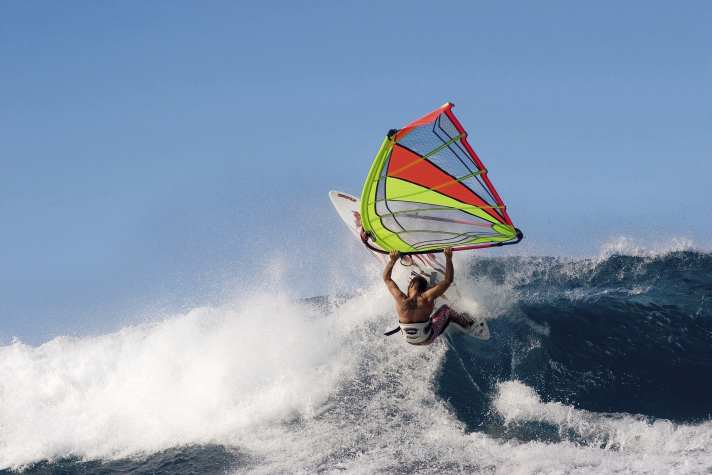Quatro shaper: Keith Teboul on waveboard evolution - from single fin to quad and thruster
Julian Wiemar
· 12.10.2025






Keith, what would you say have been the biggest milestones in the development of waveboards in the last 20 or 30 years?
By far the biggest milestone for me was when I worked with Kauli Seadi to bring the twin fin into waveboards. In 2006/07 he came to me with the idea of doing this, and I wasn't against it, but I was kind of like, oh, what, a twin? His vision was to stay closer to the wave, turn tighter and be able to finsh his turns. We gave it a go and built a few prototypes. When he came second at the PWA event in Cape Verde with the twin fin, I think he should have won the event, but hey, that's my opinion. The lines he was taking on the waves were completely different to the others and that was so cool about it. Staying much closer to the wave, finishing turns - that was a really big milestone. I think that's when the trend towards multi-fin waveboards really started - but the windsurfing world wasn't ready for it at the time.
Way, way back, before the long single-fin era, multi-fin boards used to be a thing. Why didn't they catch on back then?
I think they might have worked to some extent back then, but then Jason Polakow came along with Strapper and his single fins - what he did with those single fins changed the picture and people started looking at it and taking notes. The multi-fin boards from way back, which were mainly thrusters (three fins), were very short and somehow not efficient. The single fins on the other hand, which were a bit longer, shaped a bit more like a round pin surfboard, had more drive and were faster.
More on the topic:
So it was the twinser that set the course for the modern quad? When did thruster concepts come back into play?
Yea, and I think that changed the whole industry because if you look at it, every brand introduced twinsers and every brand introduced quads (four fins). I'm not going to say I was the one that brought it, but I think we helped shape that directional change. I think we really changed the market, which is very cool because it brought excitement and a different kind of feel to windsurfing. It was the needs of riders like Kauli wanting to turn quicker and stay closer to the waves, you know, hence the twin fin and then the quad, and then bringing the thruster back in.

What did you do differently than before?
I always like to say that we brought the Thruster to a time when rocker lines were getting more efficient, outlines were getting more efficient, everything was getting better, so these concepts just worked much better than they did back then.
What happened to the Twinser?
As these boards evolved and I started riding twin fins myself, we realised that they have a certain range of use and it was difficult to get them to work outside of that range. In general, I've found that they work well when it was smoother and lighter, where you had something to kind of push off. However, some people are now playing with twins now in onshore and I think it can make sense for that. But we realised after a few years that we wanted a bit more of that thruster feel: turn the corner and get some thrust, you know.
What about volume development? For example, what did you ride at the start of your career and what do you ride now?
That's a good question because - and I've found this now especially when building foil boards - the length of a board gives you a certain kind of volume feeling, even though the board might say it's 68 litres, it might feel bigger because of the length. I think when I first started I was riding between 68 and 74 litres. Now I'm between 77 and 85 litres, depending on the conditions. And I weigh about 74 kilos. I think volume is generally your friend. We've managed to design the boards so that they have volume and still perform very well - volume used to get in your way more than it does now.
Today the boards work with more volume, in the past the volume would get in your way more."
How did you manage to do this in terms of shape?
It has simply been a development. I can't say that there is one answer. I think it's about finding a balance between length, width and volume. So you need to be able to support the speed you're going at, which is slow. So in general, you can provide something wider. It's about finding the right outline curves and straights, in both, the outline and the rocker, to kind of enhance that slow speed. And so it's just more about that, is finding the right proportions that work well together to keep you supported, that still allow you to go through the turn. So not too wide, but not too narrow. And as the boards have gotten shorter, that also allows them to turn more quickly. So I think that the differences from in the past, where the lengths would change quite a bit to get the volume, now it's more about a more even change. And that just translates to being able to support a bigger sail and still turn because you're not going way longer. So it's a balanced approach.

So in general, everything has become more compact and efficient ...
Yes, just everything got more efficient within this compact sort of thought: the rockers, the rails, the foam flow, the edge profiles... And that's the idea here, to make the boards as efficient as possible with not too much in your way and enough to keep you going. It's about finding that fine balance.
What are the most important parameters for you when it comes to the bottom shape of a wave board? What are your options to make board turn well?
For me, probably the most important thing is the rocker. It's kind of the basis for how the board is going to move forward right from the beginning, how it's going to keep its speed, basically - that's kind of the backbone of a board for me. But everything else is almost as important, and it's all connected. There are so many directions you can go in and it's very subtle. To make a board turn, you have to understand the rider and know what they're looking for and how they ride. What I do for Levi (Siver), for example, is very different to what I do for myself. It's pretty endless what you can do. It's not just the rocker. It's a lot about the outline. It's also the way the rail runs from big to small, which allows you to kind of hold and then come around the corner with speed. And even the foam flow and the way and where you stand make a board turn well or not.
For me, the rocker is kind of the backbone of a waveboard."
Would you say that modern waveboards are generally easier to ride?
Yes, one hundred per cent. The efficiency of these boards is just so much better than it used to be. We've been able to bring all the different things together so that people have a fast board that turns well at the same time and they feel supported and not tippy. It all came from a need to bring something to the market that people could jump on and have a good time. Because it's expensive to produce a board, you really need to hit it right, so you're not wasting people's money and your own money by putting out something that doesn't work well.
If you were to put Kauli or a Marcilio Browne on a single fin from the nineties, what would look different?
Well, they wouldn't quite finish their turns and wouldn't be able to stay as close to the wave and wouldn't get quite as many turns in a section, but you'd still see very big aerials and more down-the-line kind of sailing. I think that's the main thing. There's still good things in those boards, but we've just taken those good things and developed them further into more of the times kind of sailing and surfing.
Is there a case in which you would recommend a shape from a significantly older generation to someone?
Yes, I do. I do a lot of custom boards for people, and so my demographic is very diverse. I have customers that I've had for years. And they love this one 2.55 metre long single fin board because it works for them. They just want to jump on and go like they always have. They're old school: they like that length, they like that narrowness. So, I still do boards like that, but less and less. And sometimes I try and just evolve it a little bit for them, maybe go a little shorter, try and put a little more efficient rocker in or whatever. When they're in Maui and they come into the shop, I always say, "Hey, try this new quad, just try it out. Sometimes you can convert people and there's this new spice and new life that they feel, which is really cool. We do that a lot here. If I'm working with someone new, we have a broad demo of boards available at our shop. You just have to try it out.

